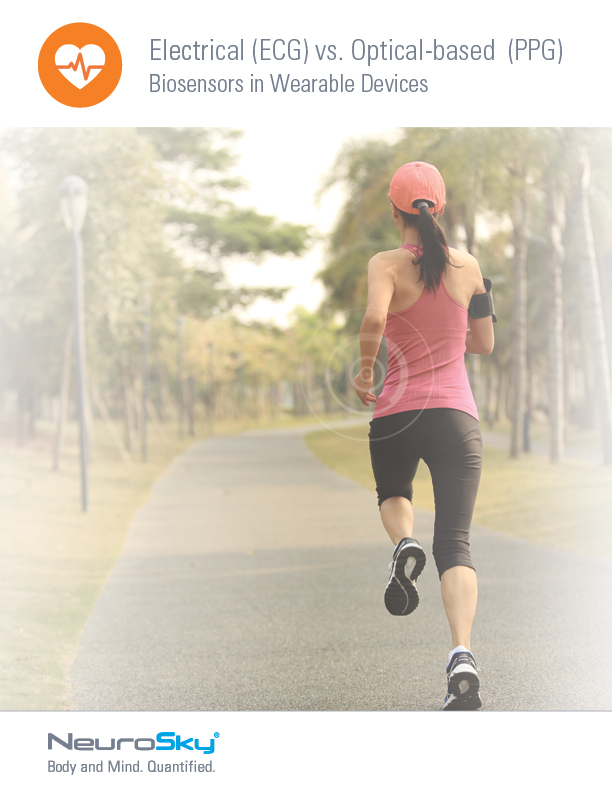The market for biosensor technology is growing at an incredible rate. In fact, it’s expected that it will reach an estimated value of over $22.5 billion by 2020. Just as demand is expanding, the technology behind biosensors is also reaching new heights. These advancements are changing the way everyone from health professionals to wearable and mobile device manufacturers are thinking about biosensors and their capabilities. This post will examine what the future of biosensor technology holds and provide you with a few exciting examples of potential use cases in the years to come.
First Things First: What Are Biosensors?
A biosensor is a device used to detect biological responses (such as your heart rate, or brain waves) and then convert those responses into measurable data. Biosensors such as our ECG CardioChip and EEG biosensor are able to capture biological data and, through the help of biometric algorithms, translate this data into understandable, actionable information.
What Are the Benefits of Biosensor Technology?
Today, biosensor technology drives much of the mobile and wearable device industry. ECG biosensors make it possible for people to use their mobile wearable devices to measure everything from their heart and breathing rates, to their stress and fatigue levels—all while going about their typical routines.
On the other hand, EEG biosensors are the core component of EEG headsets (such as our very own MindWave Mobile). These headsets are used to unleash the full potential of your mind, and can be used for everything from guided meditation to transforming into a real life superhero.
While the revolution has already begun, advancements in biosensor technology are on the cusp of opening up many exciting new doors. Let’s take a look at a few now.
Biosensor Technology Will Detect—and Potentially Prevent—Illness
Research out of Stanford University has already shown that biosensors have the potential to reveal the early onset of infection, inflammation, Lyme disease, and even the risk for diabetes. This advanced data collection capability is quickly paving the way for biosensor technology to be at the heart of personalized mobile health monitoring dashboards. Imagine being alerted when early warning signs of an illness present themselves—even before you’re experiencing any symptoms—and then being able to immediately provide that information to a physician to begin treatment. Early intervention with the help of biosensor technology will provide the opportunity to cure illness, and even prevent it before it happens.
Biosensor Technology Could Put an End to Drunk Driving
According to the National Highway Traffic Safety Administration, there were over 10,000 deaths related to alcohol-impaired crashes in the United States in 2015. Imagine how many of those crashes—and deaths—could be prevented by simply knowing you’ve had too much to drink. Engineers at the University of California in San Diego are working to make this possible with the help of biosensor technology. Described as a “biosensor tattoo”, their wearable device is able to sense changes in the electrical currents flowing through the sweat of a user in order to accurately determine blood-alcohol level. This information is then sent to the user’s cell phone, which can alert them if it’s not safe to drive.
This technology may sound familiar. That’s because measuring someone’s alcohol level using sweat has been tried before. Unfortunately, it could take up to three hours to get accurate results. With new biosensor technology, these reading take just 8 minutes—paving the way for practical real-time blood alcohol level monitoring and potentially saving thousands of lives in the process.
Biosensor Technology is on the Verge of Changing how Diabetics Monitor Their Glucose Levels
Many people living with Type 1 and Type 2 diabetes are expected to test their glucose levels between 4 and 10 times a day. This can be a time-consuming and painful process—one that many diabetics would rather avoid. In fact, research shows that 80 percent of people don’t check their glucose levels enough, despite the serious consequences this choice can have.
Advances in biosensor technology are now making it easier for diabetics to check their glucose levels. For example, the K’Track Glucose tracker by PKvitality is a bio-wearable that does away with blood tests altogether. Instead, this tracker “tastes” the skin with tiny micro-needles to analyze the chemical composition of interstitial fluid—a solution that absorbs glucose directly from the blood. This painless tracker eliminates the need to carry multiple test strips and without getting in the way of their daily activities.
Biosensor Technology is Becoming a Game Changer
Biosensor technology has the potential to make a sizeable impact on the healthcare industry, as well as the day-to-day lives of all who use them. Whether monitoring your health, or helping you make smarter decisions, biosensors have an important—and welcomed—role to play moving forward. Of course, not all biosensors are created equally, so it’s important to understand which technologies are most effective. Learn more about the biosensor technology that is ideal for your use case and to see how your different options stack up against one another—get our FREE whitepaper, Electrical (ECG) vs. Optical-based (PPG) Biosensors in Wearable Devices today!



